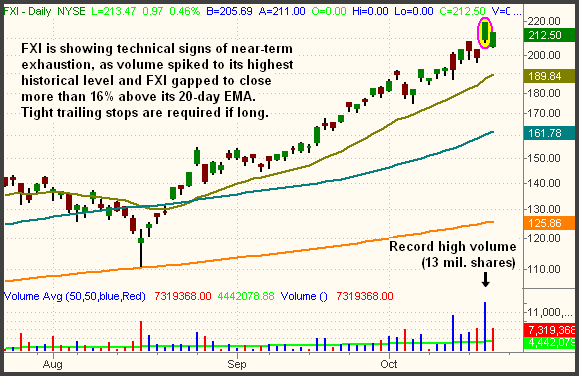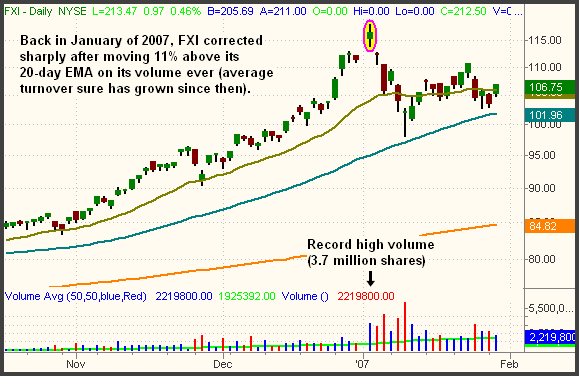| The Wagner Daily ETF Report for October 19 |
| By Deron Wagner |
Published
10/19/2007
|
Stocks
|
Unrated
|
|
|
|
The Wagner Daily ETF Report for October 19
The major indices lethargically drifted in a narrow, sideways range yesterday before finishing near the flat line. The S&P 500 slipped 0.1%, the Nasdaq Composite ticked 0.2% higher, and the Dow Jones Industrial Average was unchanged. The small-cap Russell 2000 was also flat. The S&P Midcap 400 bounced 0.2%. Each of the main stock market indexes had an "inside day," meaning their intraday trading ranges were completely contained within the previous day's highs and lows. Overall, yesterday's session was relatively uneventful.
Total volume in the NYSE eased 11%, while volume in the Nasdaq registered 19% below the previous day's level. Lighter turnover on quiet, range-bound days is common. Market internals were basically neutral. In both the NYSE and Nasdaq, advancing volume was approximately on par with declining volume.
If you happen to be long the iShares Xinhua China 25 Fund (FXI), you might consider significantly tightening your trailing stop because the ETF is exhibiting signs of potential exhaustion. Not only has this rocket ship moved too far away from its 20- and 50-day moving averages in the near-term, but current volume is indicative of a topping pattern as well. On October 17, volume spiked to 13 million shares, easily its highest single-day volume ever. Increasing volume is bullish when an ETF is breaking out of a base of consolidation, as it indicates the presence of institutional buying. However, such massive volume surges can actually be bearish when they coincide with a large upside gap on a parabolic uptrend. That's exactly what happened on October 17:

As of its October 17 close, FXI was 16.5% above support of its 20-day EMA. In steady uptrends, the 20-day EMA acts like a magnet that eventually pulls in the price of the ETF, enabling it to digest its gains before moving higher. Whenever the price gets too far away from the 20-day EMA, it gets yanked back, like a dog straying too far at the end of its leash.
On January 3 of this year, FXI gapped up sharply, while volume surged to its historical highest one-day level of 3.7 million shares. At the end of the day, FXI was about 11% above support of its 20-day EMA. Take a look at the price action that followed in this screenshot from the beginning of the year:

The week that followed the parabolic surge and volume spike saw a swift correction down to not only the 20-day EMA, but the 50-day MA as well. Obviously, this occurrence does NOT mean the same thing will happen again this time. Nevertheless, whenever an ETF rallies to more than 10% beyond its 20-day EMA and volume spikes to its highest level on record, tight stops are extremely wise. As for attempting to sell short FXI here, forget about it! Such a move would be akin to stepping in front of a Japanese bullet train. You may survive if you're fast enough, but you'll get blown to smithereens if your timing is off in the slightest bit. Rather, our point here is simply to share a few indicators that can be used for knowing when to tighten stops on runaway ETFs such as FXI.
Most of the fixed-income ETFs, which we highlighted in Thursday's Wagner Daily, continued higher yesterday. We remain long the iShares Corporate Bond (LQD), though the iShares Mid and Long-term gov't T-bonds (IEF and TLT) both look nice as well. We are still stalking the Utilities sector for a potential short entry, as the index failed to trigger to the downside yesterday. The U.S. Natural Gas Fund (UNG) rallied nicely yesterday morning, but reversed in the afternoon. Nevertheless, it is still holding at support of its recent price consolidation. We remain short the iShares Russell 2000 (IWM), while it approaches our downside target of the 200-day MA.
The S&P 500 continues to hug the lower channel support of its primary uptrend that we illustrated in yesterday's commentary. A firm close below the October 17 low would cause a definitive break of the current uptrending channel. The Nasdaq Composite still looks much better, as the index is only in the middle of its uptrending channel. Conversely, the Dow is already below its lower channel, but not by a wide enough margin to declare a confirmed break of support. It's still trying to hold on to support of its 20-day EMA, as the S&P 500 has done for the past three days. If the near-term correction in the broad market is to end, this is where the S&P and Dow must turn higher. Otherwise, both indexes may sell-off to their 50-day moving averages next week.
Open ETF positions:
Long - LQD, UNG
Short - IWM
Deron Wagner is the Founder and Head Trader of both Morpheus Capital LP, a U.S. hedge fund, and Morpheus Trading Group, a trader education firm launched in 2001 that provides daily technical analysis of the leading ETFs and stocks. For a free trial to the full version of The Wagner Daily or to learn about Wagner's other services, visit MorpheusTrading.com or send an e-mail to deron@morpheustrading.com.
|